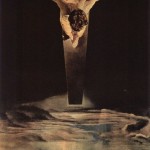When it comes to the Liturgy, I’m decidedly a “conservative,” a Benedict man through and through. I want my celebrants turned ad orientem. Bring back the communion rail. Gimme Latin, gimme smells and bells.
That being said, I do think that there the possibility of excess in that “direction”, an excess that can even shade into error.
For example, one meme that I’ve seen not infrequently on various “reform of the reform” sites is the idea that the only allowable attitude during the liturgy, during all of the liturgy, is quiet contemplative reverence.
One liturgical practice that often acts as a Rorschach Test is the Sign of the Peace. This admittedly trololol post by my Patheos Catholic Deacon Greg on the Pope’s liturgical “abuse” got me to think.
Now, if you ask me, personally, I very much dislike the Sign of Peace. To be honest, I don’t like touching people. I don’t like the awkwardness. I sympathize with those who say that its placement during the consecration, so to speak, “breaks the magic” of the moment.
All that being said, though, I also feel conscience-bound to acknowledge the fact that I know many people who have a genuine love for the Sign of Peace and its symbolism. I remember an atheist friend whom I had taken to Mass in a bid at evangelizing him, who had been moved to tears receiving the Sign of Peace. I’ve also noticed that for many Catholic “reverts” I know, they have experienced the Sign of Peace as a powerful spiritual aid in their journey of return to full communion with the Church.
In a 2014 document, the Congregation for Divine Worship describes as a liturgical abuse “the departure of the priest from the altar in order to give the sign of peace to some of the faithful.”
Well, at my Confirmation, the bishop (this was well before 2014 in his defense), who by the way is a “conservative”, said the following thing during the Sign of Peace: “Since true peace only comes from the altar, the celebrants will descend to the congregation to give them the sign of peace, and we ask that you do not give each other the sign of peace until the celebrants have reached your level.” “Since true peace comes from the altar.” I still remember it after all these years! I found it beautiful–and therefore true–then, and can’t help doing so now.
The Mass is the representation of the Paschal sacrifice, and we ought to do well to remember that, but it is also the Wedding Feast of the Lamb. It is the making-present of the entire sequence of the New Passover, including not only Holy Thursday and Good Friday, but also Easter; and since New Creation is inaugurated in the flesh of the Risen Christ–which we receive–, the kairos of the Mass is always-already eschatological. We receive worthily when we receive communion under one species, because Christ’s flesh and blood were separated on the Cross, but reunited at the Resurrection and can never be separated again. Sunday can never be a day of penance, it is always a day of celebration, the Paschal sacrifice is the New Passover by which we are freed from the bondage to sin and death and called forth as a holy, priestly people to extend Christ’s blessings to all nations.
If I had my druthers, we would come to a very simple understanding: the Mass has two parts, the Liturgy of the Word and the Liturgy of the Eucharist; the first part should be full of hymns, and vernacular, and clapping, and joy, and the Liturgy of the Eucharist should be full of Latin, and Gregorian, and veneration, and with the priest facing in the same direction as the people. And after communion, a new hymn of boisterous joy for the sending out of God’s grace-renewed people, followed by an agape feast. Not as a split-the-baby compromise, but as a recognition of the distinctiveness of the two parts of the Mass (in their profound unity); one horizontal, one vertical; one about the Church teaching the people, one about the Church drawing the people into the divine mystery. Anyhow.
The point is, there is nothing wrong with reverence, but “non-reverence” is not always and everywhere a liturgical abuse. Just for the record, the Ethiopian Church, which is an apostolic Church, has been having clapping and dancing in its liturgy since before Pope St Gregory’s liturgical reforms.
The point is, we ought to distinguish between things we don’t like for valid theological reasons, and things we don’t like for personal sentimental reasons. Very often we don’t do that well.











